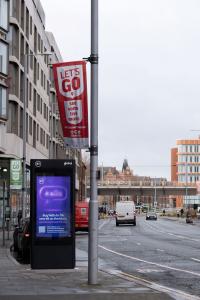BT’s mobile operator EE is undertaking a deployment of more than 500 small cells on a mix of city and BT-owned infrastructure in towns and cities in the U.K. to boost 4G coverage.
The commercial roll out will span 18 months and 200 small cells have been deployed so far, carrying live traffic. Nokia is providing the gear at launch, but a BT spokesperson told Fierce that it will also be working with other vendors to supply additional small cells.
Equipment is connected to EE’s macro network, where the operator is utilizing licensed 1800 MHz and 2600 MHz 4G spectrum, coupled with unlicensed frequencies in the 5 GHz band. 5G hasn’t launched yet, but BT said small cell equipment is 5G-ready for future upgrades.
A key part of the project is collaboration with local authorities, where BT has secured agreements to use their street furniture, including lampposts and CCTV columns to mount the small cell gear.
Small cells are needed in dense urban areas to boost coverage in places with high usage, but where it isn’t viable to deploy large macro sites. Small cells are also key in the U.S. for millimeter wave 5G, as signals don’t travel far compared to lower bands and are easily obstructed.
In recent years, U.S. tower companies like Crown Castle and operators have faced barriers to 5G small cell deployments, with delays, high fees, and sometimes pushback from state and local governments to secure siting permits and approvals. It’s a challenge the FCC has made efforts to address over the last few years, including 2018 orders (which have also faced opposition) aimed at streamlining processes by implementing a shot-clock for approval timelines and limiting costs for fees local authorities could charge.
Making network rollouts easier while also aesthetically pleasing is a desire for both operators and communities alike. AT&T recently disclosed work to address the lengthy process of new 5G small cell deployments in dense areas, which it said across the industry on average takes 12 to 18 months across site acquisition, engineering and permits. It’s utilizing new radio products from Ericsson and smart solution company Ubicquia to reduce installments to as little as 15 minutes by plugging gear into existing streetlights for nearly invisible 5G sites.
In the UK, EE is also using BT’s own assets to deploy small cells, including phone boxes and Street Hub 2.0 units.

BT launched Street Hub 2.0 units in the summer of 2021, which aim to bring services to communities while also housing mobile equipment to improve coverage. Along with small cells, the units have 75-inch digital screen displays units that allow residents and visitors to make free phone calls, get free access to up to 1 Gbps Wi-Fi, contact emergency services or charity helplines, charge devices, while also providing environmental monitoring for the local area.
BT is aiming to deploy 300 next-gen Street Hubs in the UK this year, with units already installed in Glasgow, Nottingham and London.
While the new small cell program started with BT’s infrastructure assets, the spokesperson told Fierce that its increasingly using local council street furniture “and these will be where the majority [of small cells] are sited over the coming year.”
The program also provides opportunities for BT’s wholesale unit. In addition to the EE rollout, the company said BT Wholesale can also work with other mobile operators to expand coverage through small cells on the local street infrastructure where it has agreements in place, as well as on BT assets.
“Ensuring good digital infrastructure is a priority for many councils, especially with the rise in mobile device ownership and growth in demand for data and connectivity, and they have seen the benefits that such partnerships can provide,” said Brian More O’Ferrall, director of mobile operators in BT’s enterprise business in the announcement. “Not only does it mean that average download speeds can often double in some areas, but it’s also more efficient and means there is a reduced need for new cell masts in the localities.”
UK locations teed up for a densified 4G network experience include Birmingham, Edinburgh, Glasgow, Leeds, greater London, greater Manchester, Newcastle, Nottingham, Leicester, and Cardiff. With more small cells, BT wants to boost capacity in high demand areas and said the deployment will allow EE to provide consistent data speeds of up to 300 Mbps.
In the large town of Croydon, for example, 12 EE small cells have been rolled out so far, with 20 more expected, according to Croydon Councillor Muhammad Ali. In a statement, Ali, Croydon Council’s cabinet member for sustainable Croydon, said demand for digital connectivity is set to grow and the partnership with BT brings better mobile coverage for the area’s residents, visitors and businesses.
Ali continued “it’s fantastic that our existing street furniture, together with BT assets can provide a simple and efficient solution to fast-track mobile infrastructure in our borough.”